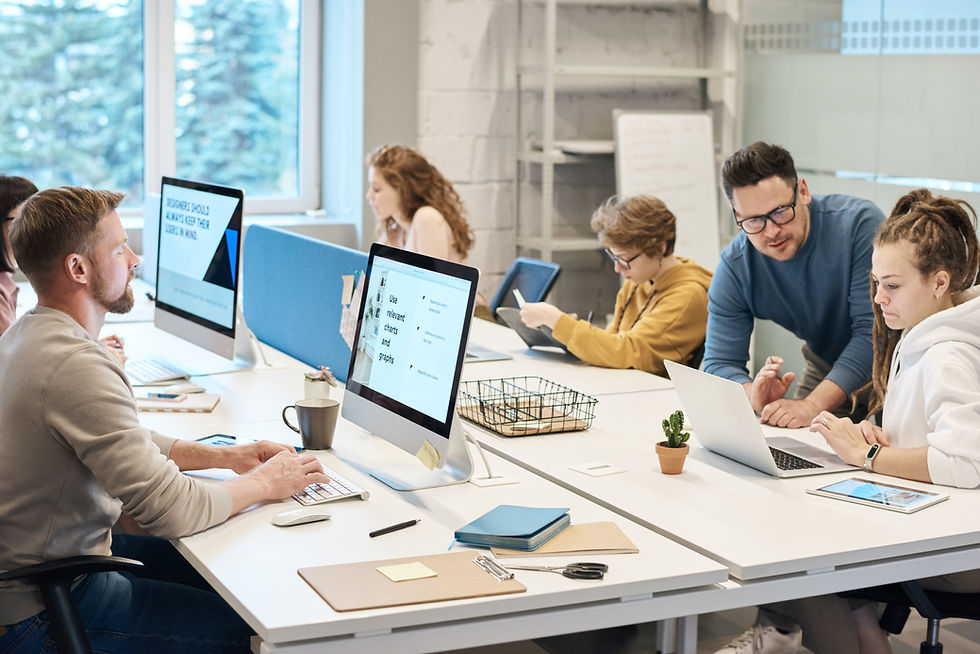Gamification in the Workplace: Empowering Business Success
- Igor Radic
- Feb 22, 2024
- 3 min read

Employers constantly seek innovative ways to drive employee engagement, productivity, and skill development in today's competitive landscape. One such solution gaining momentum is gamification. By integrating gaming elements into the workplace, companies can motivate their workforce, foster learning, and elevate overall performance. In this blog article, we explore the concept of gamification in the business world, its impacts, and how it influences various aspects of an organization.
What is Gamification in the Workplace?
Gamification involves applying game mechanics, such as points, leaderboards, badges, and challenges, to real-world work scenarios. It harnesses the innate human desire for achievement, recognition, and competition, transforming routine tasks into engaging experiences. By introducing game-like features, companies can enhance employee motivation, boost productivity, and foster a positive work environment.
According to a study by TalentLMS, 89% of employees believe that a points-based gamification system would enhance their engagement at work. [Source: TalentLMS]
Gamification Allows Employees to Set Goals
Setting clear objectives and targets is integral to any professional's journey. Gamification empowers employees to establish personal and professional goals, providing a transparent framework to track their progress. By offering real-time feedback and rewards aligned with these goals, organizations can create an atmosphere of growth and achievement.
Gamified goal-setting approaches result in a 12-36% increase in goal attainment compared to non-gamified methods. [Source: Gartner]
Gamification Allows Employees to Learn Faster
Traditional learning methods can often be monotonous and fail to captivate employees. Gamification injects an element of excitement into the learning process, encouraging participation and boosting knowledge retention. By incorporating interactive quizzes, challenges, and simulations, companies can create a stimulating learning environment, leading to faster skill acquisition and greater expertise.
Studies show that gamified e-learning experiences can improve knowledge retention rates by up to 10 times. [Source: eLearning Industry]
Gamification Encourages Employees to Complete Tough and Repetitive Tasks
Repetitive tasks can be demotivating and lead to a decline in productivity. With gamification, these mundane tasks can be transformed into engaging experiences by incorporating challenges, milestones, and rewards. By transforming routine activities into a game-like format, employees feel a sense of accomplishment, resulting in increased productivity and reduced boredom.
Gamification has been shown to increase task completion rates by 150%. [Source: TalentLMS]
Gamification Recognizes Employees Going Past Their Job Function
In dynamic workplaces, employees often have skills beyond their designated roles. Gamification allows organizations to identify and acknowledge these hidden talents, allowing employees to showcase their capabilities beyond their job descriptions. By recognizing and leveraging these skills, companies can unlock their full potential, leading to increased employee satisfaction and team collaboration.
Key Stat: Companies employing gamification witnessed a 22% increase in cross-departmental collaboration and innovation. [Source: Forbes]
Gamification Brings Positive Behavior to the Workplace
Creating a positive work culture involves cultivating behaviors that align with an organization's values and goals. With gamification, companies can encourage positive actions such as teamwork, healthy competition, and innovation. By introducing game elements that reward desired behaviors, businesses can foster an environment where employees feel motivated, valued, and invested in the company's success.
72% of employees feel that gamification inspires them to work harder. [Source: TalentLMS]
Gamification and the Concept of Group Dynamics
Effective teamwork and collaboration are vital for organizational success. Gamification can strengthen group dynamics by encouraging healthy competition, teamwork, and peer recognition. By incorporating collaborative challenges and leaderboards, employees feel a sense of camaraderie, foster closer relationships, and drive each other towards higher achievements.
Companies incorporating gamified collaboration experience a 20% increase in overall productivity. [Source: Gallup]
Gamification is reshaping the workplace landscape by combining elements of gaming and work, consequently enhancing employee motivation, fostering skill development, and promoting positive behavior. By leveraging gamification, businesses can create an engaging environment that drives productivity and cultivates a culture of continuous improvement, collaboration, and innovation. Embrace the power of gamification to unlock your organization's full potential and stay ahead in today's competitive market.
Igor Radić,
Funifier Partner & CEO




